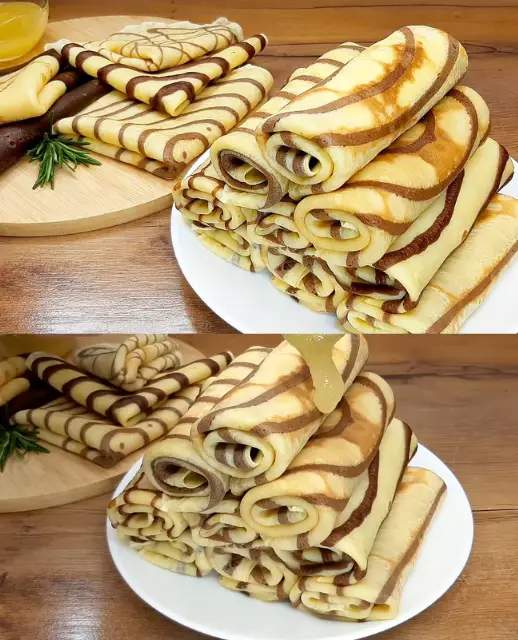Dive into the art of crepe making with our Dual Delight Crepes, where the elegant simplicity of vanilla meets the deep richness of cocoa, creating a harmonious blend of flavors that dance on your palate. These crepes offer a delightful texture, perfectly thin and tender, with each bite enveloping the senses in a luxurious taste experience.
This recipe not only promises an indulgent treat but also unveils the secret to making perfect crepes every time. By resting the batter, we ensure the flour fully absorbs the liquid, resulting in a batter that cooks up light and delicate, ideal for rolling or folding with your favorite fillings. Whether enjoyed as a sumptuous breakfast, a sweet dessert, or a sophisticated snack, these crepes bring a touch of elegance to any table setting, proving that simple ingredients can transform into an extraordinary dish with just a bit of culinary magic.
Full Recipe:
Ingredients:
- 4 eggs
- A pinch of salt
- 1 teaspoon vanillin (vanilla extract)
- 50g sugar
- 600ml milk
- 250g flour
- 50g corn starch
- 25g butter, melted
- 15g cocoa powder (for a portion of the batter)
- Honey for brushing
- Stretch wrap for resting
Directions:
- Prepare the Crepe Batter: Whisk together the eggs, salt, vanillin, and sugar. Gradually add the milk, then sift in the flour and corn starch. Mix until smooth, strain for consistency, and stir in the melted butter.
- Divide and Flavor the Batter: Split the batter into four, mixing cocoa powder into one part.
- Rest the Batter: Cover and rest for 20 minutes.
- Cook the Crepes: In a non-stick pan over medium heat, pour and spread the batter thinly. Cook each side until done.
- Create Patterns: Use chocolate batter for patterns, then pour plain batter over.
- Serve: Brush with honey, roll up, and enjoy warm.
Prep Time: 25 minutes | Cooking Time: 30 minutes | Total Time: 55 minutes
Kcal: 180 kcal (per crepe) | Servings: 16 crepes
Why This Recipe Works
Our Dual Delight Crepes stand out for several reasons. Firstly, the balance between the light, airy texture of the crepe and the rich, nuanced flavors of vanilla and cocoa offers a taste experience that is both sophisticated and deeply satisfying. The secret to their perfect texture lies in the resting of the batter, a crucial step that allows the flour to fully hydrate, ensuring crepes that are wonderfully light and delicate.
Additionally, the versatility of this recipe is a testament to the creative possibilities that simple ingredients can offer. Whether you prefer your crepes filled with fresh fruits, drizzled with chocolate sauce, or simply enjoyed with a sprinkle of sugar, these crepes provide an exquisite base for a myriad of fillings.
Step-by-Step Guidance
We’ve broken down the recipe into detailed steps to ensure that even those new to crepe making can achieve perfect results:
- Prepare the Crepe Batter: Achieving a smooth batter is crucial for delicate crepes. Whisking the eggs, vanillin, salt, and sugar together before gradually incorporating the milk ensures a smooth, lump-free texture. Sifting the flour and cornstarch into the mix avoids any flour clumps, while the addition of melted butter lends a subtle richness to the batter.
- Divide and Flavor: This step introduces the “dual” aspect of our crepes. By dividing the batter and adding cocoa powder to one portion, you create the opportunity for beautiful, contrasting designs that are as pleasing to the eye as they are to the palate.
- Rest the Batter: Resting is not a step to be skipped. This allows the gluten in the flour to relax, leading to a batter that spreads easily and cooks into tender, flexible crepes that are perfect for rolling or folding.
- Cooking to Perfection: The key to cooking crepes is a hot, non-stick pan and a small amount of batter. This recipe ensures that your crepes will be thin and evenly cooked, with just the right amount of crisp at the edges.
- Serving Suggestions: While these crepes are delightful with just a brush of honey, they are also the perfect canvas for your culinary creativity. Fill them with whipped cream and berries, nut butter and bananas, or even savory fillings for a twist.
Nutritional Information and Servings
Understanding the nutritional content of what you eat is important. Each crepe from this recipe contains approximately 180 kcal, making it a treat that can fit into a balanced diet. This recipe yields 16 crepes, perfect for feeding a crowd or for making ahead and enjoying throughout the week.
Customizing Your Crepes
One of the joys of crepe making is the endless possibilities for customization. Here are a few ideas to inspire your creations:
- Fruit-Filled Delights: Fill your crepes with a mixture of fresh berries, sliced bananas, or stewed apples. Top with a dollop of whipped cream or a scoop of vanilla ice cream for an extra indulgent treat.
- Chocolate and Hazelnut Spread: For a rich and decadent option, spread a layer of chocolate and hazelnut spread inside your crepes, adding sliced strawberries for a touch of freshness.
- Savory Options: While these crepes are designed with a sweet profile in mind, omitting the sugar and vanilla extract from the batter transforms them into a versatile base for savory fillings such as sautéed mushrooms, spinach and feta, or ham and cheese.
Dietary Adaptations
This recipe is adaptable to various dietary needs with a few simple substitutions:
- Gluten-Free: Replace the wheat flour with your favorite gluten-free flour blend and ensure that your cornstarch is certified gluten-free.
- Dairy-Free: Use a plant-based milk alternative such as almond, soy, or oat milk in place of dairy milk, and opt for a dairy-free butter alternative.
- Vegan: Substitute the eggs with your preferred egg replacement, such as flax eggs or a commercial vegan egg substitute, and follow the dairy-free adaptations mentioned above.
Presentation Tips
The visual appeal of your crepes can elevate the dining experience. Here are a few tips to create visually stunning dishes:
- Contrast and Color: Use the dual aspect of the batter to create designs like swirls, hearts, or abstract patterns. Adding colorful toppings like fruits, edible flowers, or a sprinkle of powdered sugar can turn each crepe into a work of art.
- Layering: Stack crepes with layers of filling between each for a decadent crepe cake. This works especially well for celebratory occasions or when you simply want to impress your guests.
- Serving Style: Consider the occasion and your audience when deciding how to serve your crepes. Rolled, folded into quarters, or served open-faced, each method offers a different visual and eating experience.
Frequently Asked Questions
Here are some common questions about making Dual Delight Crepes, along with their answers, to help you achieve crepe-making success:
Can I make the batter ahead of time?
Absolutely, preparing the batter ahead of time is not only possible but recommended for achieving the best texture. When you allow the batter to rest in the refrigerator for up to 24 hours, the flour particles fully absorb the liquid, air bubbles introduced during mixing dissipate, and the gluten developed during mixing relaxes. This results in a smoother, more cohesive batter that cooks into crepes with a superior texture — tender and delicate, yet strong enough to wrap around your favorite fillings without tearing. Before using the rested batter, give it a gentle stir to reincorporate any ingredients that may have settled at the bottom. This step ensures consistency in your batter and, subsequently, your crepes.
My crepes are tearing when I flip them. What am I doing wrong?
Tearing can be a common issue, especially for those new to crepe making. The problem often stems from a combination of factors, including batter consistency, pan condition, and flipping technique. If your crepes are too thin, they might not have enough structure to withstand flipping. To combat this, ensure your batter has the consistency of thin cream; if it’s too runny, add a little more flour. Your cooking surface also plays a crucial role — a well-seasoned or non-stick pan is essential for crepes. If you’re using a non-stick pan and still encountering issues, a light brushing of butter or oil before each crepe can help. Additionally, patience is key; wait until the edges of the crepe lift from the pan and it slides easily when you gently shake the pan. Using a thin-edged spatula can also make a big difference, allowing you to gently lift and flip the crepe without tearing.
Can I freeze the cooked crepes?
Freezing crepes is a fantastic way to enjoy them later, and they freeze exceptionally well. To freeze, cool the crepes completely after cooking to prevent any steam from creating ice crystals, which can affect texture. Place parchment or wax paper between each crepe to prevent them from sticking together, then stack and wrap them securely in plastic wrap or place them in a zip-lock bag or airtight container. Frozen this way, crepes can last for up to two months. When you’re ready to enjoy, there’s no need to thaw them overnight; simply remove as many as you need and gently reheat them in a skillet over low heat or in the microwave for a few seconds. This method revives the crepes, making them nearly as good as when they were first made.
How do I make my crepes more or less sweet?
Adjusting the sweetness of your crepes allows you to customize them for various fillings and occasions. If you prefer a sweeter crepe, especially if you’re planning to fill them with something less sweet or tangy like lemon juice and sugar, you might want to increase the sugar in the batter. Conversely, if your filling is very sweet or you’re aiming for a more nuanced flavor profile, you can reduce the sugar. Start with a tablespoon less or more, depending on your preference, and adjust from there. Remember, the batter itself should be subtly sweet, as it’s the combination of crepe and filling that creates the overall flavor experience.
What’s the best way to achieve thin crepes?
Achieving thin, delicate crepes is all about technique and the right batter consistency. Your batter should be liquid enough to quickly cover the bottom of the pan in a thin layer. Pour a small amount of batter into the center of the hot pan, then immediately lift and tilt the pan in a circular motion to spread the batter thinly and evenly across the surface. If you find the batter doesn’t spread easily, it may be too thick; try thinning it with a little milk. The first one or two crepes might not be perfect as you adjust the batter consistency and get a feel for the pan’s heat and motion, but this is a normal part of the crepe-making process. With practice, you’ll find the perfect balance to create beautifully thin, even crepes every time.
Conclusion
Embarking on the journey of making Dual Delight Crepes is not just about cooking; it’s an exploration of flavors, textures, and culinary creativity. This recipe provides a perfect balance of simplicity and sophistication, making it accessible to beginners yet still enjoyable for seasoned cooks. By experimenting with fillings, toppings, and presentation, you can make each crepe-making experience uniquely your own.
Whether you’re looking to impress guests, treat yourself to a delicious breakfast, or explore new dessert avenues, the Dual Delight Crepes recipe offers a versatile and delightful option. Remember, the most important ingredients you can bring to this recipe are patience and passion. So, gather your ingredients, fire up your stovetop, and prepare to delight in the art of crepe making. Happy cooking, and may your crepes be as delightful to make as they are to eat!

